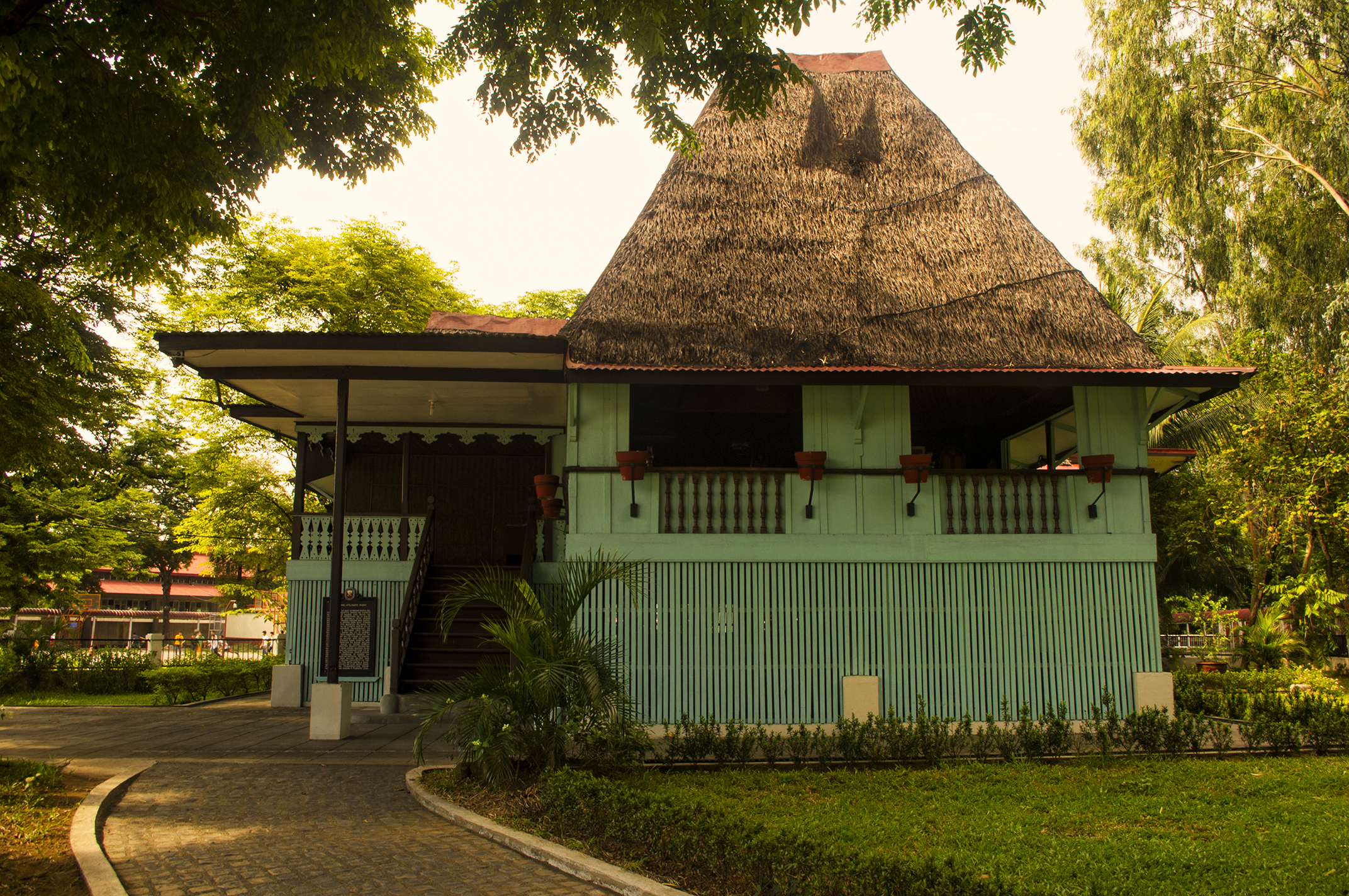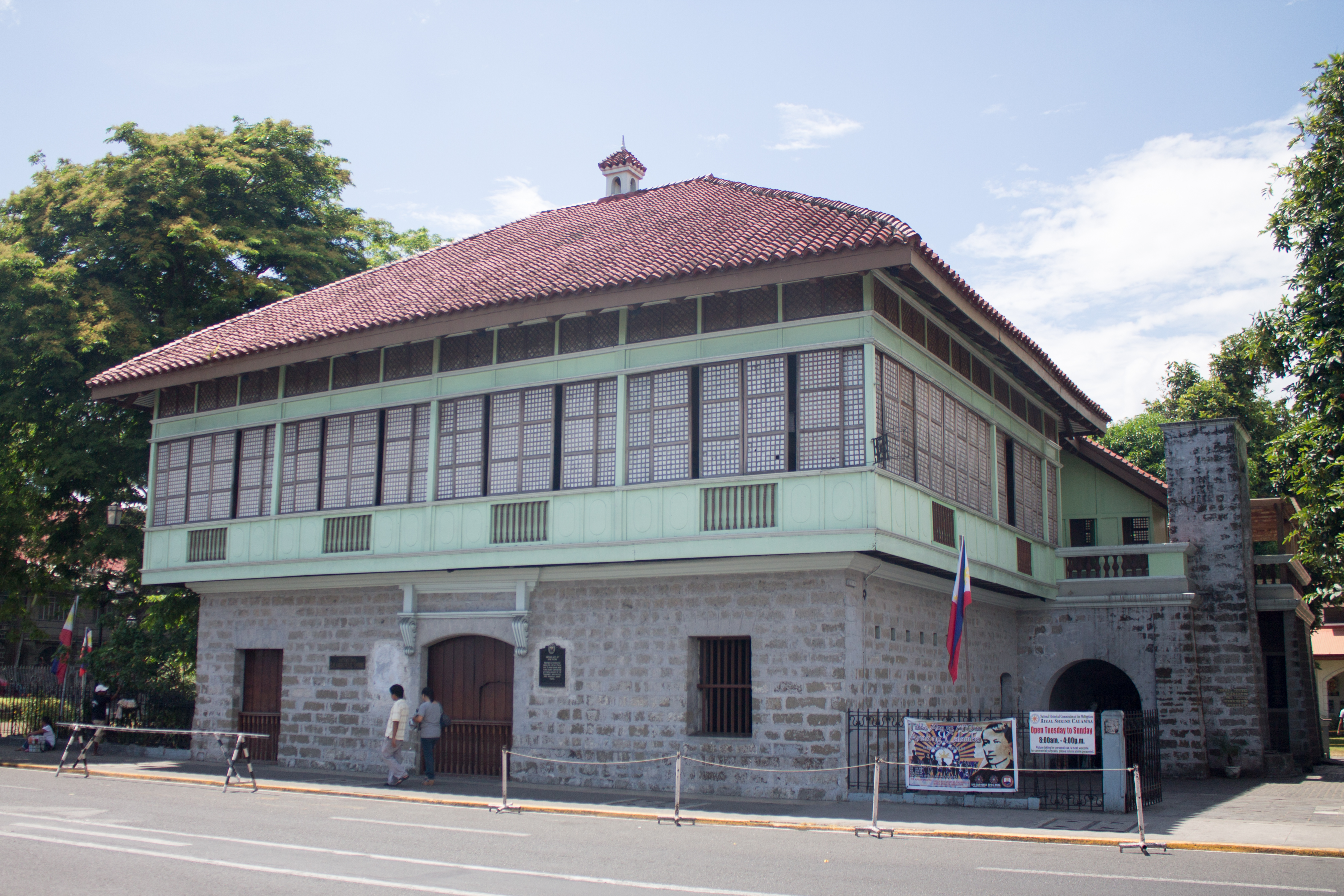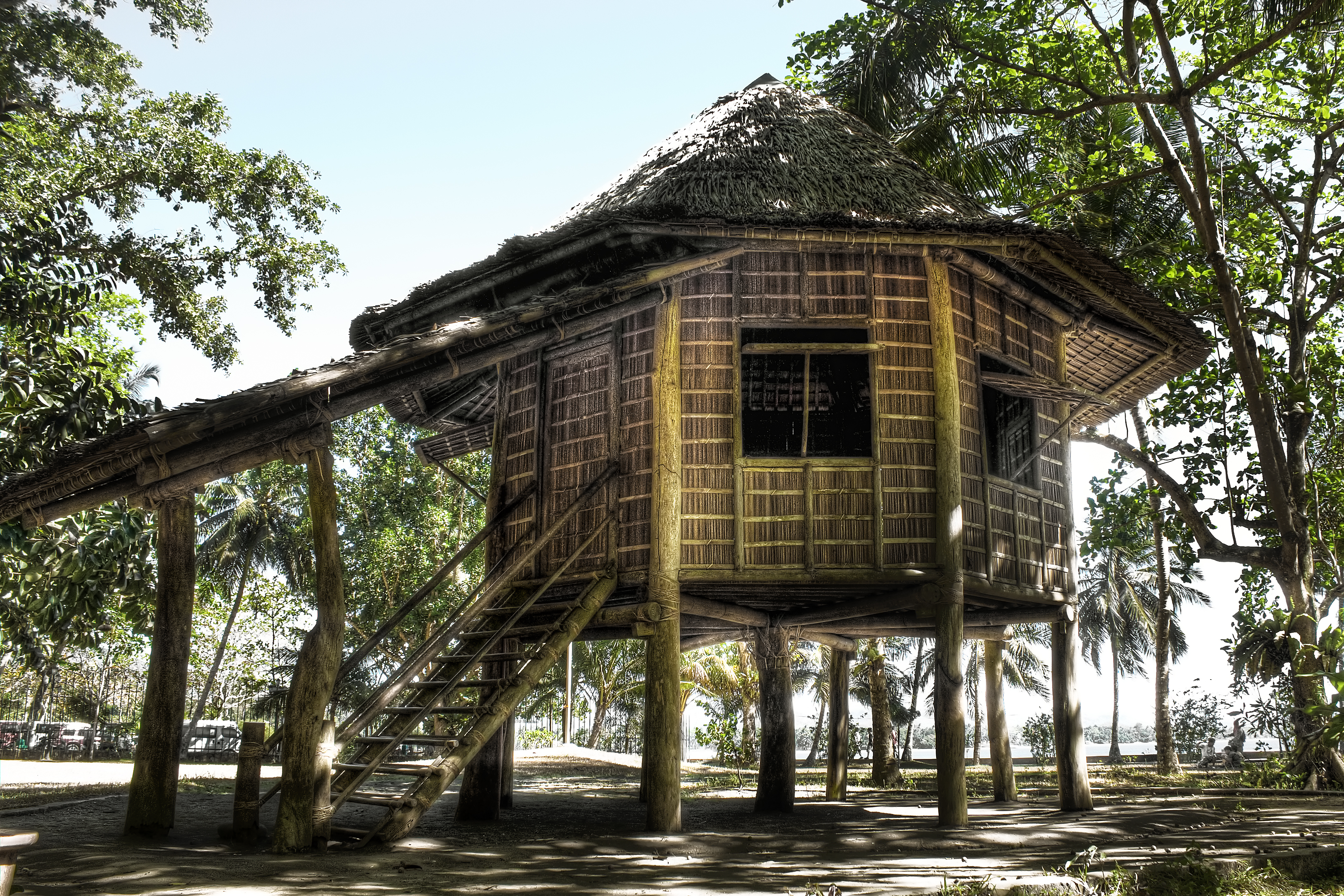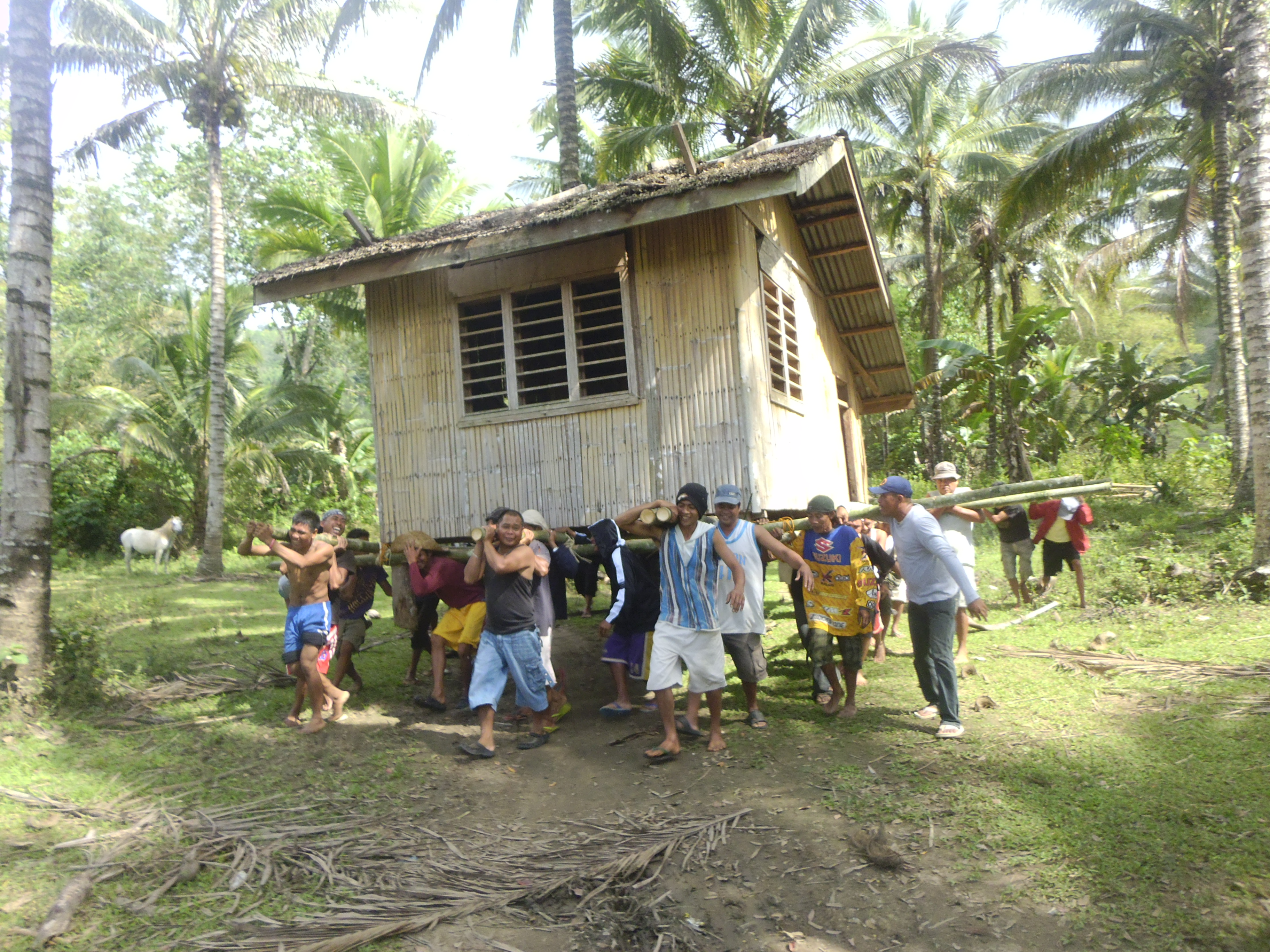bahay kubo on:
[Wikipedia]
[Google]
[Amazon]

 The ''bahay kubo'', also known as ''payag'' (Nipon) in the
The ''bahay kubo'', also known as ''payag'' (Nipon) in the
 The
The


 It is originally and is still typical for Bahay kubo to be mostly organic in material and be elevated, mainly for vernacular and superstitious reasons and because of floods during wet season and the hot dry land during summer can cause a lot of problems for the inhabitants. Similar conditions in Philippine lowland areas have led to characteristics "typical" of examples of Bahay Kubo.
It is originally and is still typical for Bahay kubo to be mostly organic in material and be elevated, mainly for vernacular and superstitious reasons and because of floods during wet season and the hot dry land during summer can cause a lot of problems for the inhabitants. Similar conditions in Philippine lowland areas have led to characteristics "typical" of examples of Bahay Kubo.  With few exceptions arising only in modern times, most Bahay Kubo are on stilts: the living area is accessed by ladder. This naturally divides the house into three areas: the living area in the middle, the area beneath it (referred to in Tagalog as the ''silong''), and the roof space (''bubungan''), which may or may not be separated from the living area by a ceiling (''atip'').
With few exceptions arising only in modern times, most Bahay Kubo are on stilts: the living area is accessed by ladder. This naturally divides the house into three areas: the living area in the middle, the area beneath it (referred to in Tagalog as the ''silong''), and the roof space (''bubungan''), which may or may not be separated from the living area by a ceiling (''atip'').
 The walls are always of light material such as wood, bamboo rods, or bamboo mats called " amakan" (or "sawali"). As such, they tend to let some coolness flow naturally through them during hot times and keep warmth in during the cold wet season.
The cube shape distinctive of the ''Bahay Kubo'' arises from the fact that it is easiest to pre-build the walls and then attach them to the wooden stilt-posts that serve as the corners of the house. The construction of a ''Bahay Kubo'' is therefore usually modular, with the wooden stilts established first, a floor frame built next, then wall frames, and finally, the roof.
The walls are always of light material such as wood, bamboo rods, or bamboo mats called " amakan" (or "sawali"). As such, they tend to let some coolness flow naturally through them during hot times and keep warmth in during the cold wet season.
The cube shape distinctive of the ''Bahay Kubo'' arises from the fact that it is easiest to pre-build the walls and then attach them to the wooden stilt-posts that serve as the corners of the house. The construction of a ''Bahay Kubo'' is therefore usually modular, with the wooden stilts established first, a floor frame built next, then wall frames, and finally, the roof.
 ''Bahay kubo'' are typically built with large windows, to let in more air and natural light. The most traditional are large awning windows, held open by a wooden rod. Sliding windows are also common, made either with plain wood or with wooden
''Bahay kubo'' are typically built with large windows, to let in more air and natural light. The most traditional are large awning windows, held open by a wooden rod. Sliding windows are also common, made either with plain wood or with wooden

 American architect and engineer
American architect and engineer
Eight minute video of building a modern Nipa hut
{{Huts Houses in the Philippines Huts Stilt houses Wooden buildings and structures in the Philippines Vernacular architecture

 The ''bahay kubo'', also known as ''payag'' (Nipon) in the
The ''bahay kubo'', also known as ''payag'' (Nipon) in the Visayan languages
The Bisayan languages or Visayan languages are a subgroup of the Austronesian languages spoken in the Philippines. They are most closely related to Tagalog and the Bikol languages, all of which are part of the Central Philippine languages. M ...
and, is a type of stilt house indigenous to the Philippines
The Philippines (; fil, Pilipinas, links=no), officially the Republic of the Philippines ( fil, Republika ng Pilipinas, links=no),
* bik, Republika kan Filipinas
* ceb, Republika sa Pilipinas
* cbk, República de Filipinas
* hil, Republ ...
. It often serves as an icon of Philippine culture
The culture of the Philippines is characterized by cultural diversity. Although the multiple ethnic groups of the Philippine archipelago have only recently established a shared Filipino national identity, their cultures were all shaped by the ...
. The house is exclusive to the lowland population of unified Spanish conquered territories. Its design heavily influenced the colonial-era ''bahay na bato
''Bahay na bato'' (Tagalog, literally "house of stone", also known in Visayan as ''balay na bato'' or ''balay nga bato; in Spanish as Casa Filipino'') is a type of building originating during the Philippines' Spanish colonial period. It is an ...
'' architecture.
Etymology
Filipino
Filipino may refer to:
* Something from or related to the Philippines
** Filipino language, standardized variety of 'Tagalog', the national language and one of the official languages of the Philippines.
** Filipinos, people who are citizens of th ...
term ''báhay kúbo'' roughly means "country house", from Tagalog. The term ''báhay'' ("house") is derived from Proto-Malayo-Polynesian
Proto-Malayo-Polynesian (PMP) is the reconstructed ancestor of the Malayo-Polynesian languages, which is by far the largest branch (by current speakers) of the Austronesian language family. Proto-Malayo-Polynesian is ancestral to all Austronesi ...
*balay, "public building" or "community house"; while the term ''kúbo'' ("hut" or " ne-roomcountry hut") is from Proto-Malayo-Polynesian *kubu, "field hut n rice fields
N, or n, is the fourteenth letter in the Latin alphabet, used in the modern English alphabet, the alphabets of other western European languages and others worldwide. Its name in English is ''en'' (pronounced ), plural ''ens''.
History
...
.
The term "nipa hut", introduced during the Philippines' American colonial era, refers to the Hut
A hut is a small dwelling, which may be constructed of various local materials. Huts are a type of vernacular architecture because they are built of readily available materials such as wood, snow, ice, stone, grass, palm leaves, branches, hid ...
version of Bahay kubo. Nipa or anahaw thatching materials are often used for the roofs. However, not all bahay kubo are huts or used nipa materials.
History
Classical period (Pre-hispanic Era)
Distinction between each tribes and cultures' style may have been more visible during the pre-hispanic period. Different architectural designs are present among each ethnolinguistic group in what is now the Philippines and throughout the Southeast Asia and Pacific as part of the whole Austronesian Architecture. They were designed to endure theclimate
Climate is the long-term weather pattern in an area, typically averaged over 30 years. More rigorously, it is the mean and variability of meteorological variables over a time spanning from months to millions of years. Some of the meteorologi ...
and environment of the Philippines. These structures were temporary, made from plant materials like bamboo. The accessibility of the materials made it easier to rebuild when damaged by a storm or earthquake.
Hispanic Era
The advent of the Spanish Colonial era introduced the idea of building more permanent communities with the church and government center as focal points. Christianized people such as the Tagalogs, Visayans, Ilocanos, Kapampangans, Bicolanos, Cagayanons, Mestizos, Criollos, Chinese and Japanese etc. were made to live lowland, this newly formed culture, with most population coming from Austronesian origin, each having their own distinct traditions of Austronesian architecture, dating back even before the Hispanic period, collectively evolved a certain style of construction that has become synonymous to the lowland culture based on the Austronesian architecture. These houses, are now known as the Bahay kubo. Appearance varies from simplehuts
A hut is a small dwelling, which may be constructed of various local materials. Huts are a type of vernacular architecture because they are built of readily available materials such as wood, snow, ice, stone, grass, palm leaves, branches, hid ...
, later known by the Americans as Nipa huts, to mansions like Bahay na bato. Architectural Designs and ornamentations varies from From standard, Chinese, Americas, European to eclectic . The new community also setup made construction using heavier, more permanent materials desirable. Some of these materials included bricks, mortar, tiles and stone. Finding European construction styles impractical in local conditions, Spanish and Filipino builders quickly adapted the characteristics of the ''bahay kubo'' and combined it with the Hispano-American Antillean (Caribbean) architectural style, resulting in the indigenous ''bahay na bato'' ("stone house") or ''bahay luma'' ("old house" or "traditional house").
Bahay na bato

Bahay na bato
''Bahay na bato'' (Tagalog, literally "house of stone", also known in Visayan as ''balay na bato'' or ''balay nga bato; in Spanish as Casa Filipino'') is a type of building originating during the Philippines' Spanish colonial period. It is an ...
or Casa Filipino is a noble version of bahay kubo with mainly Spanish
Spanish might refer to:
* Items from or related to Spain:
**Spaniards are a nation and ethnic group indigenous to Spain
**Spanish language, spoken in Spain and many Latin American countries
**Spanish cuisine
Other places
* Spanish, Ontario, Can ...
and Chinese influence. Its design evolved throughout the ages but maintained its nipa hut architectural roots. Its most common appearance is like that of stilt nipa hut that stands on Spanish style stone blocks or bricks as a foundation instead of wood or bamboo stilts.
The ''bahay na bato'', followed the nipa hut's arrangements such as open ventilation and elevated apartments. It was popular among the elite or middle class and integrated the characteristics of the nipa hut with the style, culture, and technology of Spanish architecture
Spanish architecture refers to architecture in any area of what is now Spain, and by Spanish architects worldwide. The term includes buildings which were constructed within the current borders of Spain prior to its existence as a nation, when ...
. The most obvious difference between the two houses would be the materials that was used to build them. The ''bahay na bato'' was constructed out of brick and stone rather than the traditional bamboo materials. It is a mixture of native Filipino, Spanish and Chinese influences. During the 19th century, wealthy Filipinos built some fine houses, usually with solid stone foundations or brick lower walls, and overhanging, wooden upper story/stories with balustrades Ventanillas and capiz shell
The windowpane oyster (''Placuna placenta'') is a bivalve marine mollusk in the family of Placunidae. They are edible, but valued more for their shells (and the rather small pearls). The shells have been used for thousands of years as a glass su ...
sliding windows, and a Chinese tiled roof or sometimes Nipa roof which are today being replaced by galvanized roof. Bahay na bato had a rectangular plan that reflected the Hispano-American Antillean architectural style integrated with traditional Philippine style. Today these houses are more commonly called ancestral houses.
Characteristics
 It is originally and is still typical for Bahay kubo to be mostly organic in material and be elevated, mainly for vernacular and superstitious reasons and because of floods during wet season and the hot dry land during summer can cause a lot of problems for the inhabitants. Similar conditions in Philippine lowland areas have led to characteristics "typical" of examples of Bahay Kubo.
It is originally and is still typical for Bahay kubo to be mostly organic in material and be elevated, mainly for vernacular and superstitious reasons and because of floods during wet season and the hot dry land during summer can cause a lot of problems for the inhabitants. Similar conditions in Philippine lowland areas have led to characteristics "typical" of examples of Bahay Kubo.  With few exceptions arising only in modern times, most Bahay Kubo are on stilts: the living area is accessed by ladder. This naturally divides the house into three areas: the living area in the middle, the area beneath it (referred to in Tagalog as the ''silong''), and the roof space (''bubungan''), which may or may not be separated from the living area by a ceiling (''atip'').
With few exceptions arising only in modern times, most Bahay Kubo are on stilts: the living area is accessed by ladder. This naturally divides the house into three areas: the living area in the middle, the area beneath it (referred to in Tagalog as the ''silong''), and the roof space (''bubungan''), which may or may not be separated from the living area by a ceiling (''atip'').
Bubong (Roof)
The traditional roof shape of the ''Bahay Kubo'' is tall and steeply pitched, ending in long eaves. A tall roof creates space above the living area through which warm air could rise, giving the ''Bahay Kubo'' a natural cooling effect even during the hot summer season. The steep pitch allows water to flow down quickly at the height of the monsoon season while the long eaves give people a limited space to move about around the house's exterior when it rains. The steep pitch of the roofs are often used to explain why many ''Bahay Kubo'' survived the ash fall from the Mt. Pinatubo eruption, when more ’modern’ houses collapsed from the weight of the ash.Silong
Raised up on hardwood stilts which serve as the main posts of the house, ''Bahay Kubo'' have a ''silong'' (the Tagalog word also means "shadow") area under the living space for a number of reasons, the most important of which are to create a buffer area for rising waters during floods and to prevent pests such as rats from getting up to the living area. This section of the house is often used for storage, and sometimes for raising farm animals, and thus may or may not be fenced off.Silid (Living Space)
The main living area is designed to let in as much fresh air and natural light as possible. Smaller ''Bahay Kubo'' will often have bamboo slat floors which allow cool air to flow into the living space from the ''silong'' below (in which case the ''silong'' is not usually used for items which produce strong smells) A ''Bahay Kubo'' may be built without an ''atip'' (ceiling) so that hot air can rise straight into the large area just beneath the roof and out through strategically placed vents.Dingding (Walls)
 The walls are always of light material such as wood, bamboo rods, or bamboo mats called " amakan" (or "sawali"). As such, they tend to let some coolness flow naturally through them during hot times and keep warmth in during the cold wet season.
The cube shape distinctive of the ''Bahay Kubo'' arises from the fact that it is easiest to pre-build the walls and then attach them to the wooden stilt-posts that serve as the corners of the house. The construction of a ''Bahay Kubo'' is therefore usually modular, with the wooden stilts established first, a floor frame built next, then wall frames, and finally, the roof.
The walls are always of light material such as wood, bamboo rods, or bamboo mats called " amakan" (or "sawali"). As such, they tend to let some coolness flow naturally through them during hot times and keep warmth in during the cold wet season.
The cube shape distinctive of the ''Bahay Kubo'' arises from the fact that it is easiest to pre-build the walls and then attach them to the wooden stilt-posts that serve as the corners of the house. The construction of a ''Bahay Kubo'' is therefore usually modular, with the wooden stilts established first, a floor frame built next, then wall frames, and finally, the roof.
Dungawan (Windows)
 ''Bahay kubo'' are typically built with large windows, to let in more air and natural light. The most traditional are large awning windows, held open by a wooden rod. Sliding windows are also common, made either with plain wood or with wooden
''Bahay kubo'' are typically built with large windows, to let in more air and natural light. The most traditional are large awning windows, held open by a wooden rod. Sliding windows are also common, made either with plain wood or with wooden Capiz shell
The windowpane oyster (''Placuna placenta'') is a bivalve marine mollusk in the family of Placunidae. They are edible, but valued more for their shells (and the rather small pearls). The shells have been used for thousands of years as a glass su ...
frames which allow some light to enter the living area even with the windows closed. In more recent decades inexpensive jalousie windows became common.
In larger examples, the large upper windows may be augmented with smaller windows called ''ventanillas'' (Spanish for "little window") underneath, which can be opened for ventilation to let in additional air on especially hot days.
Batalan
Some ''Bahay Kubo'', especially those built for long-term residences, feature a ''batalan'' ("wet area") distinct from other sections of the house — usually jutting out somewhat from one of the walls. Sometimes at the same level as the living area and sometimes at ground level, the ''batalan'' can contain any combination of cooking and dishwashing area, bathing area and, in some cases, a lavatory. ''Batalan'' used for cooking and washing dishes were known as ''banggéra'' inPhilippine Spanish
The Philippines (; fil, Pilipinas, links=no), officially the Republic of the Philippines ( fil, Republika ng Pilipinas, links=no),
* bik, Republika kan Filipinas
* ceb, Republika sa Pilipinas
* cbk, República de Filipinas
* hil, Republ ...
(also ''banggerahan'' or ''pinganan''). It is named after the banga earthen water-jars which are placed on a jutting structure of spaced bamboo or wooden slats.
Kamalig
A granary detached from the house where harvested rice is kept.Construction materials
The walls of the living area are made of light materials. Posts, walls, and floors are typically made of wood or bamboo and other light materials. The thatched roof is often made of nipa, anahaw or some other locally plentiful plant. Thus, making it easier for the nipa huts to be moved if needed.Cultural significance
A nipa hut is an icon of Philippine culture as it represents the Filipino value of ''bayanihan
Communal work is a gathering for mutually accomplishing a task or for communal fundraising. Communal work provided manual labour to others, especially for major projects such as barn raising, "bees" of various kinds (see below), log rolling, and ...
'', which refers to a spirit of communal unity or effort to achieve an objective.Arts
A famous folk song '' Bahay Kubo'' often sung in schools which mentions a small house surrounded by vegetables goes like this: It is a very cultural but misleading song as not all Bahay kubo are small and surrounded by vegetables. Some early and original variants are even palace or mansion like and used by native royalties or in the colonial era used by Captains and governors. Some original mosque and churches in the Philippines are even in Nipa hut style.Legacy
 American architect and engineer
American architect and engineer William Le Baron Jenney
William Le Baron Jenney (September 25, 1832 – June 14, 1907) was an American architect and engineer who is known for building the first skyscraper in 1884.
In 1998, Jenney was ranked number 89 in the book ''1,000 Years, 1,000 People: Ran ...
visited the Philippines for three months in 1850. He noticed that during a storm, the Nipa Hut structures are very "light and flexible". It only dances and sways through the storm. This inspired him to copy the flexibility of the frame of the Nipa hut. In 1879, he built the first lighter building. And in 1884, he built the Home Insurance Building in Chicago, the first metal-framed skyscraper in United States. Because of this, he became known as "The Father of Modern American Skyscrapers", which became the model of all the modern skyscrapers in the world.
The bahay kubo inspired architects such as Francisco Mañosa and Leandro Locsin by incorporating elements of the bahay na bato into their own designs e.g. Cultural Center of the Philippines
The Cultural Center of the Philippines ( fil, Sentrong Pangkultura ng Pilipinas, or CCP) is a government-owned and controlled corporation established to preserve, develop and promote arts and culture in the Philippines.Presidential Decree No. ...
, National Arts Center
The National Arts Center is a building complex situated in Mount Makiling, Los Baños, Laguna, the Philippines. The establishment was inaugurated in 1976. Its theater is the Tanghalang Maria Makiling or the NAC Center, which has an audience capac ...
, Coconut Palace, and Light Rail Transit stations.
Similar architecture
''Bahay kubo'' is an example of Austronesian architecture. Other examples of native Austronesian architecture in the Philippines also include structures like the ''fayu'' and ''katyufong'' of Bontoc; ''bale'' and ''abong'' of Ifugao; ''binayon'' of Kalinga; ''binangiyan'' of Kankanai; ''jin-jin'' of Ivatan; ''baley'' of the Matigsalug; ''binanwa'' of Ata; ''bolloy'' of Klata; ''baoy'' of Ovu-Manuvo; ''bale'' of the Bagobo Tagabawa; ''bong-gumne'' of Blaan; ''uyaanan'' of Mansaka; ''gunu-bong'' of T'boli; ''lawig,'' ''mala-a-walai,'' ''langgal'', ''lamin'' and ''torogan'' of the Maranao; ''bay-sinug'' of Tausug; ''lumah'' of Yakan; and others.See also
* Ancestral houses of the Philippines * Architecture of the Philippines * Kawayan Torogan * Las Casas Filipinas de Acuzar * Rumah Melayu *Rumah adat
''Rumah adat'' are traditional houses built in any of the vernacular architecture styles of Indonesia, collectively belonging to the Austronesian architecture. The traditional houses and settlements of the several hundreds ethnic groups of Indone ...
* Vernacular architecture
Vernacular architecture is building done outside any academic tradition, and without professional guidance. This category encompasses a wide range and variety of building types, with differing methods of construction, from around the world, bo ...
References
External links
Eight minute video of building a modern Nipa hut
{{Huts Houses in the Philippines Huts Stilt houses Wooden buildings and structures in the Philippines Vernacular architecture